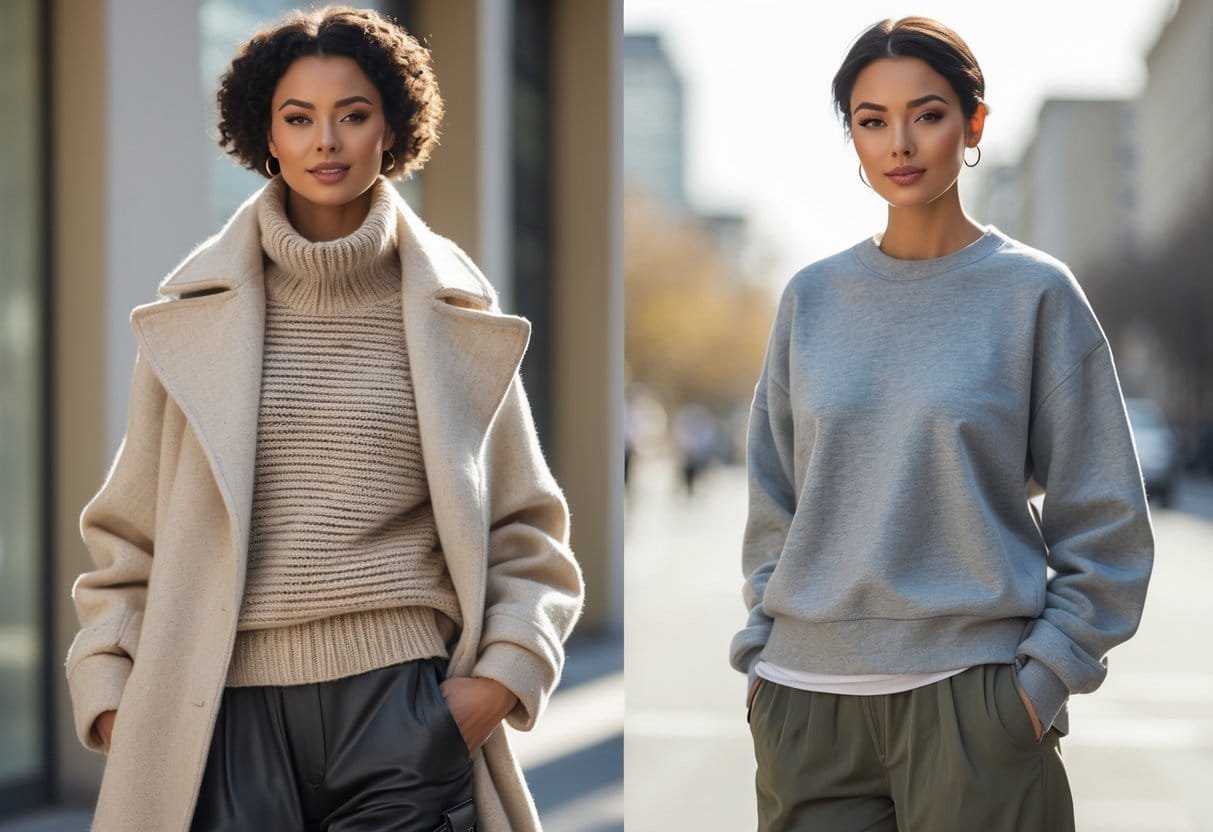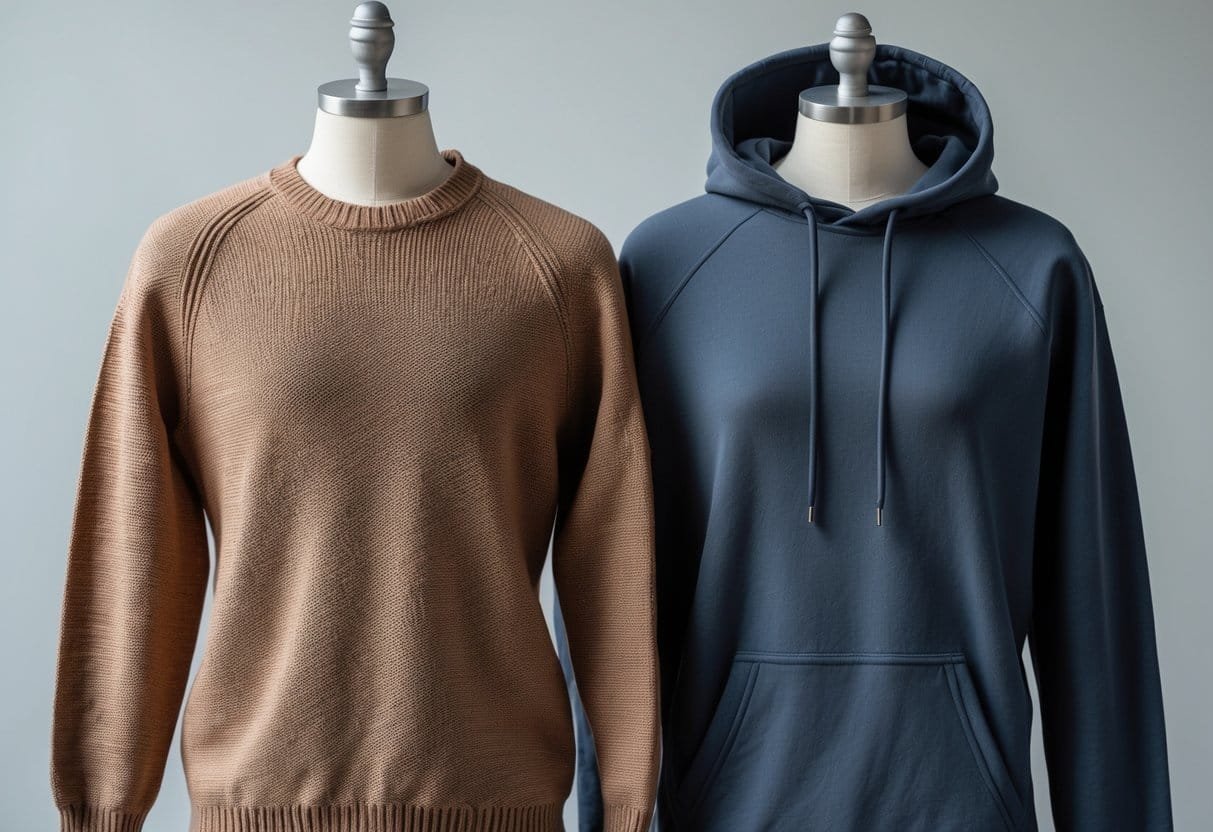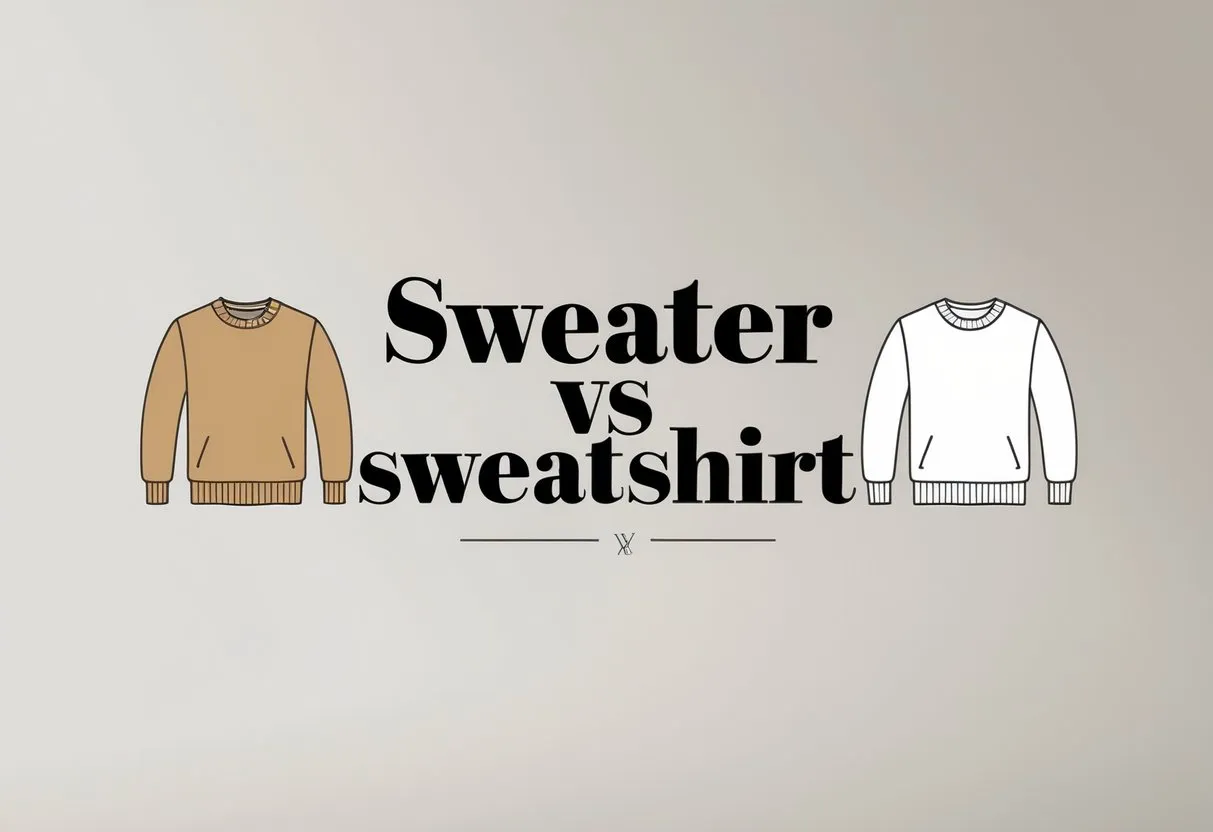Sweater vs Sweatshirt : Key Differences and Style Tips
Many people confuse sweaters vs sweatshirts because both are casual, warm tops often worn in cooler weather. They can seem similar at a glance, but each serves a different purpose and has unique features. Understanding these differences helps people choose the right item for comfort and style.

The key difference lies in the material and design, which affect how each garment looks, feels, and is used. Knowing what separates a sweater from a sweatshirt makes it easier to pick the best option for various occasions and weather conditions. This article explores those differences in simple terms.
1) Material differences:

Sweaters are made by knitting yarn, which creates a stretchy and textured fabric. This knitting process allows for patterns and designs to be woven into the garment. Common materials for sweaters include wool, cotton, and synthetic fibers.
Sweatshirts, on the other hand, are made from woven fabric panels. They often use cotton or polyester blends with a smooth surface outside. Inside, sweatshirts usually have a soft fleece or French terry lining to add warmth and comfort.
The woven fabric in sweatshirts gives them a thicker and smoother feel compared to sweaters. This also makes sweatshirts more durable for everyday wear. While sweaters have an airy, bumpy texture, sweatshirts feel soft and plush inside.
2) Design:

Sweaters come in many designs. They can have buttons, zippers, or no closures at all. This makes them versatile for different looks, from casual to more formal.
Sweaters may include styles like cardigans that open in front or pullovers that do not. They often feature varied necklines such as crewneck, V-neck, or turtleneck.
Sweatshirts usually have a simple pullover design. They rarely include buttons or zippers in the front.
Some sweatshirts have hoods or a front zipper, but these are less common than pullover styles. Their design focuses on comfort and casual wear.
Overall, sweaters offer more design variety than sweatshirts. The choice depends on the wearer’s style and the occasion.
3) Warmth:

Sweaters are made from knitted fabrics like wool, cotton, or synthetics. These materials trap heat well, making sweaters good at keeping the body warm in cold weather.
They also allow some air to pass through, which helps manage moisture and keeps the wearer comfortable.
Sweatshirts, on the other hand, are usually made from heavier cotton or fleece. They provide moderate warmth but are not designed for very cold conditions.
The fleece lining in sweatshirts helps keep some heat inside but does not insulate as much as the thicker knit of a sweater.
Sweatshirts are better suited for cool weather or casual wear, while sweaters are a better choice when higher insulation is needed.
In summary, sweaters offer more warmth and are preferred for colder temperatures. Sweatshirts provide comfortable warmth but are less effective at keeping the cold out.
4) Formality:

Sweaters are often seen as more formal than sweatshirts. They work well in semi-formal situations like offices, dinners, or events that require a polished look.
Many sweaters come in neutral colors and clean designs. This helps create a tidy appearance when worn over a shirt or under a jacket.
Sweatshirts, on the other hand, are made from thicker cotton fabrics. They usually have a relaxed fit and are better suited for casual wear.
People typically wear sweatshirts for comfort during informal activities. These include weekends, exercise, or casual social gatherings.
Sweaters can bridge the gap between formal and casual. Sweatshirts are mostly limited to casual settings because of their sporty style and material.
5) Fit:

Sweaters often have a tailored fit that shapes to the body. This makes them look polished and neat. They can be worn under jackets or with dress shirts because of their sleek style.
Sweatshirts, on the other hand, are designed for comfort. They usually have a loose and relaxed fit. This allows for easy movement and a casual look.
Sweatshirts often include features like hoods or pockets, which add to their laid-back style. They are popular for sports, lounging, or casual outings.
The fit difference affects when and how each is worn. Sweaters suit formal or semi-formal occasions, while sweatshirts are best for informal and comfortable settings.
6) Care instructions:

Sweaters often need gentle care to keep their shape and texture. Many sweaters should be hand washed or cleaned on delicate cycles using cold water. Wool and other natural fibers are sensitive and may shrink or become damaged if washed too roughly.
Sweaters usually dry best when laid flat. Avoid wringing or twisting to remove water, as this can stretch the fabric. Some machine-washable sweaters can be dried on low heat, but checking the care label is important.
Sweatshirts are generally easier to care for. Most are machine washable and can handle regular wash cycles. Sorting sweatshirts by color and washing them inside out helps protect their surface and preserve color.
They dry quickly and can often be tumble dried on low heat without damage. This makes sweatshirts practical for everyday use, requiring less special care than sweaters.
7) Common occasions:

Sweaters are often chosen for offices or formal events. They provide a polished look and can easily be layered over shirts or under jackets. This makes them a good option for meetings, dinners, and social gatherings where a neat appearance is important.
Sweatshirts, on the other hand, are best suited for casual and active settings. People often wear them for sports, outdoor activities, or relaxing at home. Their design focuses more on comfort and practicality rather than formality.
While sweaters add style and warmth in semi-formal or dressy occasions, sweatshirts offer coziness and ease during leisure time. Choosing between them depends largely on the event and the need for either a smart look or casual comfort.
8) Style versatility:

Sweaters are considered more versatile when it comes to dressing up. They work well with dress pants and tailored trousers, making them suitable for casual office days or smart-casual events. A neat sweater can create a polished look without needing a jacket.
Sweatshirts usually have a more relaxed, sporty vibe. They pair easily with jeans, joggers, or other activewear. This makes sweatshirts ideal for casual outings, workouts, or lounging at home.
Sweaters come in different fabrics such as wool or cashmere, which adds to their dressier feel. Sweatshirts are typically made from heavier cotton or fleece, which keeps the look informal and comfortable.
Because of these differences, sweaters can fit into a wider range of outfits including business casual or semi-formal. Sweatshirts are best kept for laid-back settings or athletic styles. This distinction helps when choosing clothes based on the occasion.
9) Fabric texture:

Sweaters are made from knitted fabric that feels soft and often has a textured surface. The knitting creates patterns and variations in the material, which can range from fine and smooth to chunky and rough. This texture gives sweaters a classic look and a cozy feel.
Sweatshirts use a different type of fabric made from jersey fleece. This fabric has a smooth outer surface and a soft, fuzzy lining inside. The fleece texture is consistent and even, without the patterns seen in knits.
The smooth exterior of sweatshirts makes them ideal for printing graphics or embroidery. Meanwhile, the knit texture of sweaters can make that process harder because of its uneven surface.
In terms of comfort, both fabrics offer softness but in different ways. Sweaters provide warmth through their knit structure, while sweatshirts rely on the fleece lining to keep the wearer comfortable.
10) Layering:

Sweaters are designed to be layered under coats easily. Their thinner or medium-weight fabrics fit well beneath jackets without adding too much bulk. This makes them useful for colder weather when extra warmth is needed under an outer layer.
Sweatshirts, on the other hand, often work as outerwear or mid-layers. They tend to be thicker and more casual. People commonly wear sweatshirts alone or under lighter jackets, but not usually under heavy coats.
Layering with sweaters allows for flexibility in warmth and style. They can be paired with base layers underneath and coats on top. Sweatshirts provide warmth and comfort but are less commonly used as a base layer.
Both sweaters and sweatshirts offer options for layering. The choice depends on the weather, activity, and style preferences. Sweaters are more versatile under coats, while sweatshirts are convenient as stand-alone or mid-layers.
Key Differences Between Sweaters and Sweatshirts

Sweaters and sweatshirts differ mainly in their fabric types and how they are made. These differences affect how they look, feel, and how warm they are. Understanding these details helps when choosing the right piece for comfort or style.
Fabric and Material Comparison
Sweaters are usually made from knitted fabrics like wool, cashmere, or merino. These natural fibers tend to be warmer and softer. Sweaters can also include blends with synthetic fibers for added durability or stretch. These materials often make sweaters pricier but provide better insulation.
Sweatshirts, on the other hand, commonly use cotton or polyester blends. This fabric is thicker and has a smooth, soft surface inside, made for casual comfort. Sweatshirts are less breathable than sweaters but are often more lightweight. Their materials make them easier to care for and more affordable.
| Feature | Sweaters | Sweatshirts |
|---|---|---|
| Typical Fabric | Wool, Cashmere, Merino | Cotton, Polyester Blends |
| Warmth | High | Moderate |
| Care | Often hand wash or dry clean | Machine washable |
| Price Range | Usually higher | Usually lower |
Construction and Design Variations
Sweaters are knitted using loops of yarn. This allows for stretch and a variety of patterns like cables or ribs. The knit construction gives sweaters a flexible and loose fit, which can be dressy or casual.
Sweatshirts are made by sewing together pieces of fabric, usually fleece or jersey. This results in a sturdier, heavier garment. Sweatshirts have a more structured fit with features like ribbed cuffs and waistbands to hold shape. They often include hoods or pockets, adding to their casual style.
Design-wise, sweaters are more versatile, often worn with shirts or blouses. Sweatshirts are focused on comfort and casual wear, popular for sports or lounging.
| Feature | Sweaters | Sweatshirts |
|---|---|---|
| Construction Type | Knitted | Sewn from fabric pieces |
| Fit | Looser, stretchable | Structured, fitted with cuffs |
| Common Design | Patterns, intricate details | Solid colors, hoods, pockets |
| Style | Dressy or casual | Casual, sporty |
Usage Scenarios and Style Considerations

Choosing between a sweater and a sweatshirt depends on factors like weather and how the garment fits into an outfit. Both have unique uses and style impacts based on their materials and shapes.
Seasonal Suitability
Sweaters are usually made from knitted fabrics like wool or cotton, making them better for colder weather. They provide warmth and are often breathable, which helps in cool, dry conditions.
Sweatshirts typically use fleece or thick cotton blends, offering soft, cozy warmth. They work well in chilly, casual settings but may be too warm for mild days.
In winter, sweaters can pair well with dressier outfits, while sweatshirts suit casual or sporty looks. When layering in late fall or spring, a sweatshirt may be enough on its own or under a light jacket.
Layering and Outfit Integration
Sweaters work well as a middle or top layer in outfits. Thin, fine-knit sweaters fit easily under coats or blazers. Chunky sweaters serve as statement pieces for more casual or smart-casual styles.
Sweatshirts tend to be bulkier and are often worn as outer layers. Their relaxed fit pairs naturally with jeans, joggers, or casual pants.
Styling tips:
- A sweater can be combined with collared shirts for a cleaner look.
- Sweatshirts pair best with sneakers and casual footwear.
- Picking solid colors or minimal designs makes layering simpler.
Both garments offer versatile options but fit best in different settings depending on outfit goals.
Frequently Asked Questions
Sweaters vs sweatshirts differ in materials, design, warmth, and style. Their uses change based on comfort needs, occasion, and weather. Knowing these details can help choose the right garment.
What are the key differences between sweaters and sweatshirts?
Sweaters are made by knitting yarn, often wool or similar fibers. They may have buttons or zippers and fit more closely to the body.
Sweatshirts are made from woven cotton or fleece. They usually come in a pullover style with a loose, relaxed fit.
Which is generally considered warmer, a sweater or a sweatshirt?
Sweaters provide more warmth because of their thicker knit and insulation.
Sweatshirts offer moderate warmth but are usually lighter and less insulating than sweaters.
How do sweaters and sweatshirts differ in terms of fashion for men and women?
Sweaters tend to be more formal and suit semi-formal or professional settings for both men and women.
Sweatshirts are casual and often worn for comfort or sporty looks, fitting relaxed, everyday styles.
Why might someone choose a sweatshirt over a sweater?
Someone may pick a sweatshirt for comfort, ease of movement, and casual occasions.
Sweatshirts are better for layering and informal use because of their loose fit and soft fleece material.
What are the functional purposes of choosing a sweater versus a sweatshirt?
Sweaters are chosen for warmth and polished appearance, suitable for cooler weather and smarter outfits.
Sweatshirts serve well in casual or athletic settings and mild cold when flexibility and comfort are priorities.
How do the materials used in sweatshirts and sweaters affect their comfort and warmth?
Sweaters are knitted and made from wool or cotton blends, providing strong insulation and a structured feel.
Sweatshirts are made of cotton blends or fleece, soft to the skin but less insulating, focusing on comfort and breathability.







